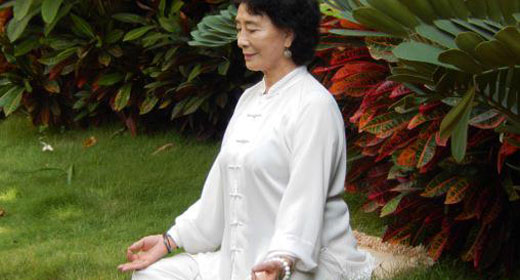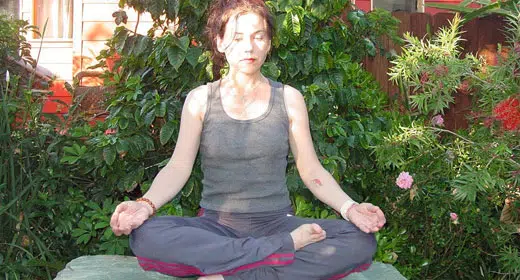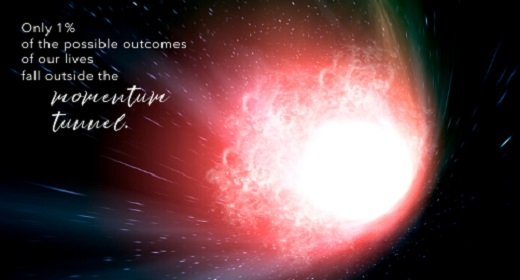by Sonia Ribas: Yogiraj Alan Finger is the founder of ISHTA (Integrated Science of Hatha, Tantra and Ayurveda) and member of the Yogin’ it Family….

We had the honor to spend a morning with Alan Finger in his apartment in NYC. He shared with us his incredible biography: he has not learned yoga, he has lived it since he was a child. Alan is genuine, compassionate and loving. He beautifully combines spiritual insights with scientific, biological explanations as to why practicing asana, meditation, breathing techniques, tantra and practicing stillness for 18 minutes a day is so beneficial. He has a positive, calming, yet incredibly powerful energy: 100% kapha. Thanks Alan for your wisdom, generosity and light.
Namaste. I am Alan Finger and I’m doing this interview with Sonia for Yogin’ it.
I’d like to give you a little bit of an introduction to how I began my yoga practice and how the concept of ISHTA Yoga developed.
My father was shell shocked in the Second World War. He became a drug addict and alcoholic. His father, my grandfather, was a very wealthy businessman so he kept trying to push my father into businesses. However, being a drug addict and alcoholic, my father spent a lot of his time in homes, and was not doing well at all.
My grandfather sent my father on a business trip to America, where he stayed at the Ambassador Hotel in Los Angeles. In the hotel, Yogananda happened to be giving a lecture. Although he was drunk, my father, together with some colleagues, joined Yogananda’s lecture. After the lecture, Yogananda went up to my father and bowed to him, but my father didn’t understand why. Yogananda then asked my father to stand up and told him that he was going to become a famous yogi. He went on to say that he was going to teach my father Kriya Yoga, after which he would go to India and then return to South Africa and become quite a renowned yogi. He added that one of his sons would follow in his footsteps. Of course, that was me.
Upon returning to South Africa, my father started to teach and do yoga. When I was living in South Africa, there were 6 million white people, and Indians formerly from India, so the Indian population was very large and strong. These Indians invited all their teachers to South Africa; their famous swamis, yogis, etc. We met with Iyengar, who came to South Africa before he became famous.
My father invited all these swamis and yogis into our house. We had a big house on a large plot of land shaped like a triangle bordered by three roads. Eventually, a part of the house was renovated into an ashram, a brilliant piece of architecture. So we had an ashram in the house and we had an apartment where the swamis and yogis would come and stay.
I ended up growing up surrounded by all these teachers. By the time I was 15, I began my yoga practice. Actually my 65th birthday was last week Friday, which marked the 50th anniversary of my yoga practice. I woke up every morning with my father who would switch the light on and off at 4:30am. I performed neti, went downstairs and practiced with my father. We did an hour and a half of pranayama and kriya, followed by an hour and a half of asana. A part of the asana was headstand. We had to build up to and stand in headstand for 30 minutes a day. So I had a real intense practice, which began at 15 years old. In the 50 years I have been practicing yoga, I only missed seven days. Two of them were when I was still young and I wanted to see how I would feel if I didn’t do my practice. Of course I didn’t feel as clear and enlightened, so I just do it.
This is how ISHTA developed. But when I was young and was surrounded by all of these teachers, I noticed how different teachers would contradict themselves and each other. I started asking how that was possible. Iyengar said you must do pranayama like this, and some other teacher would say you must do it with a different mudra and differently. So I would go back to all of them and would ask, “Why? What is the difference here?” and they said to me, “Well we do this because of this and if you do it this way it’s a different energy that you move in.”
Anyway, to make a long story short, I wanted to put this information together because it was too conflicting. It was just too vast and too all over the place. I wasn’t into religion, but I felt what yoga, the kriya techniques, the asanas, the pranayama and the mudras did for me. I studied all of the different sister sciences of India which were hatha yoga, tantra and ayurveda. Those were the teachers my father and I pulled together into our lives. I wanted to systemize these sciences, but met with a lot of resistance from all my teachers, who thought we didn’t need it. But I knew I did need this if I wanted to bring yoga to the world. So we put together this system of ISHTA Yoga.
About ISHTA
ISHTA is actually an acronym for Integrated Science of Hatha, Tantra and Ayurveda.
But ISHTA Yoga means, “What is the yoga? What is the practice that resonates with an individual?” Everybody is so different, their bodies, their minds, their bone structures, and their breath; everything is different. It’s not appropriate to say, this is the practice you do, and everybody should do that practice. It’s what is going to resonate, what’s right for the individual.
About yoga and how it helps people
Yoga is about trying to find homeostasis in the cells of your own body and your own mind, in the way your own system governs it all. Our body has 72 to 100 trillion cells and they have to be governed by something. How do you learn how to govern these cells and keep them in homeostasis? That is what yoga is really all about. Once you achieve homeostasis with yourself, then you have to achieve homeostasis with the universe. So we have the two types of Samadhi, which basically is what yoga is: savikalpa samadhi or how to find homeostasis in yourself and nirvikalpa samadhi or how to find homeostasis with the universe.
What is Samadhi? It is how Patanjali defines as “What is yoga?” It is being in the now! But how can you be in the now when your mind keeps moving away from it? So the tools of yoga and his whole ashtanga teach how to remove the vriti, or the activity of your mind, and be in the now. Atha yoganusasanam, which is the first of the Sutras, is often described as now begins the teaching of yoga, but it is not. Now is yoga; in the now is yoga. But it is impossible to capture the now, unless you go into Samadhi. So the purpose of all the asanas, pranayamas, kriyas are to get you into this place where you are no longer in duality. Because when you no longer are in duality you have to be still.
What asana teaches us is incredible. It opens and aligns our bodies and balances the “Ha” (sun) and the “Tha” (moon). Pranayama calms and clears and stretches the mind, and balances the prana.
The kriya techniques take your consciousness and make it complete again, but the goal is ultimately to sit still. In tantra and ISHTA we want you to sit still for 18 minutes a day that is called sadhana. With sadhana, one practices to become whole, achieve homeostasis within yourself, and homeostasis with the Universe. You need to just sit still and allow it to happen for 18 minutes a day.
18 minutes?
18 minutes was just a time that was taught to me by my tantric teachers and my father. It was not until I was in New York that one of my students told me about an article in the New York Times saying that in deep sleep a human being needs Delta rhythm. They need 18 minutes of that for the system to completely refresh. Most people don’t even get a minute or two of deep sleep, most of the time they are dreaming and REM. Yoga is so amazing because we can put you into that state, in Delta. There are tools, practices and kriyas to get you into that state and sustain it, and that’s where the magic comes into yoga.
When Patanjali spoke to us about siddhis and the practice of samyama, and how to make those siddhis happen, he wasn’t just hallucinating. Sure some of them are pretty far-fetched, but the main siddhis are how to bring that intelligence of the universe back into my living. It inspires my life, and it inspires everybody I come in touch with. That is what yoga is. It definitely is not putting your toe in your ear and standing on one hand. But, having said that, it can be a wonderful practice to balance your body and allow you ultimately to find the right bandhas so that you can sit for 18 minutes in stillness.
How do you help people through yoga?
I take this and I try to spread it to all human beings. I try to teach them how to find this. I have been initiated into Shakti through a lineage of teachers; which I continue, and practice. It’s amazing because we take this ancient lineage and bring it into today’s living. We don’t have much religion involved or any kind of “ism,” because all individuals have it inside them and just need to find it.
What is a Yogi?
A yogi is a person who can actually get into Samadhi and sit for the 18 minutes. Even if one is striving to sit for 18 minutes, I would consider him or her a yogi. So what does it take? It takes asana, pranayama and kriya to get there. But then you have to sit, because if you cannot sit in stillness, you are not getting yoga. A yogi is one who gets yoga. A yogi is one who can sit in the now. Every human being has the ability to do it.
What is the sign of an enlightened Yogi?
There is something called shakti in our bodies. Shakti is Mother Nature’s force residing in our sacrum, down in the base. Everybody is born with shakti. It moves away from shivas at the crown and when our body manifests through brahma nadi; it resides in the base.
Unfortunately, we are completely victims of our belief patterns. A little baby doesn’t come out holding on to his head saying, “Oh my God, how do I get milk today?” The baby is just there, it needs food, it cries …
But we were all those complete human beings. Look what we have become, we have learned things; our attitudes began, our learning. Those belief patterns in yoga are called avidya: ignorance. They make you ignorant of the truth. The belief patterns or avidya create the kundalini to choke the shakti; the snake, the coil of energy with beliefs chokes the way the shakti manifests in our being.
So the more that that becomes choked, the less shakti resonates through your body. The more that it is free, the more that the shakti is there. It is radiance, it is a glow, it is life, it helps and uplifts everyone – that is the sign of a Yogi.
Which teachers have inspired you?
Well my father was my main teacher. His initiated name was Kavi Yogi Swarananda Mani Finger. Next was Swami Venkatesananda from the Sivananda ashram, who also studied tantra. Swami Nishraisananda from the Ramakrishna Mission was a scientist and engineer. He had all the science stuff, which really resonated with me.
Venkatesananda thought me my Ayurveda, my marma and shakti birth. That’s the lineage I was initiated into.
Shuddhananda Bharati was my final teacher. He only came to visit us twice over two years for three weeks each. Bharati was the one who really solidified all the teachings as Tantra, as what we were doing.
Those four were really my main teachers, but then Iyengar came and I listened to him and learned and saw how he dealt with the body. What he really inspired me to consider was how to do that in consciousness and relate the two. So he sparked off an incredible thing in me when I saw how particular he was with the body, I wanted to link it to the doshas, to prana, and to the chakras. How do I make that accuracy with all three bodies, all three shariras, work together?
What would you say to someone who wants to try yoga for the first time?
Find the right teacher for you. Because you might be a person who likes to exercise and wants to sweat, so you might go to Bikrams’ classes. But you might be Pitta, and all they do at Bikram is teaching everybody the same routine, in the same heat and the same thing. That can be damaging to a person who has aggravated or excess Pitta.
So really, to try and find the right teacher and the right practice is correct. Sometimes you might be attracted to a certain type of yoga and go to that, but in time you’ll allow yourself to grow, allow yourself to experience all different types of yoga so you can actually find which is the one that’s ISHTA for you, which is the one that resonates with your spirit, and helps you to be able to sit and do nothing for 18 minutes and be in homeostasis.









































